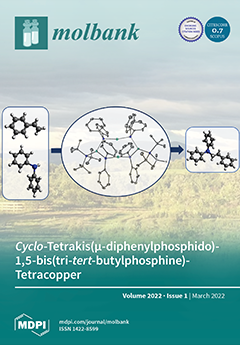An Ag(I)formamidine cluster Ag
6L16 (
1) and an Ag(I)formamidine coordination polymer Ag
7(
L2)
2 2 (
L1 =
N,
N′-bis(2,6-disopropylphenyl) formamidine dithiocarbamate and
L2 =
N,
N′-mesityl formamidine dithiocarbamate) have been synthesized
[...] Read more.
An Ag(I)formamidine cluster Ag
6L16 (
1) and an Ag(I)formamidine coordination polymer Ag
7(
L2)
2 2 (
L1 =
N,
N′-bis(2,6-disopropylphenyl) formamidine dithiocarbamate and
L2 =
N,
N′-mesityl formamidine dithiocarbamate) have been synthesized from the reactions of
L1 and
L2 with AgNO
3 respectively. The complexes were characterized using spectroscopic and analytical methods, including single-crystal X-ray diffraction. In the structure of
1, a six vertex distorted square bi-pyramidal octahedron is formed from an Ag
6 core. The
N,
N′-bis(2,6-disopropylphenyl) formamidine dithiocarbamate ligands stabilize this core through two main –CS
2 bridging modes giving a propeller like structure. In the structure of
2, each of the two Ag(I) centers are bridged by two
N,
N′-mesityl formamidine dithiocarbamate ligands forming 8-member Ag
2(CS
2)
2 metallacycles with an inversion center in the middle of the Ag—Ag argentophilic bond. The metallacycles are connected through Ag—S bonds forming ribbons in the crystallographic
a-axis. The Ag(I) centers are coordinated to two
N,
N′-mesitylformamidine dithiocarbamates through the dithiocarbamate S atoms. The thermal decomposition of complexes
1 and
2 had similar thermograms with one major weight loss activity and the formation of elemental silver particles thereafter.
Full article





